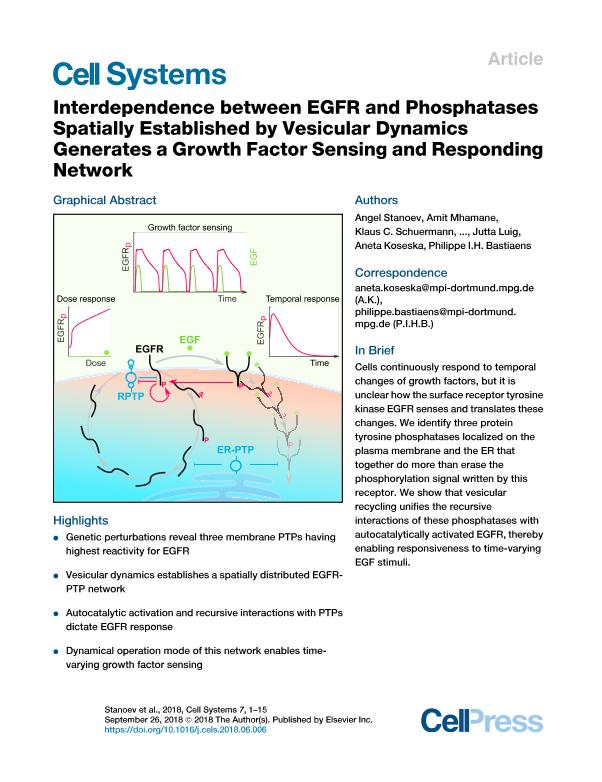Mostrar el registro sencillo del ítem
dc.contributor.author
Stanoev, Angel
dc.contributor.author
Mhamane, Amit
dc.contributor.author
Schuermann, Klaus C.

dc.contributor.author
Grecco, Hernan Edgardo

dc.contributor.author
Stallaert, Wayne
dc.contributor.author
Baumdick, Martin
dc.contributor.author
Brüggemann, Yannick
dc.contributor.author
Joshi, Maitreyi S.
dc.contributor.author
Roda Navarro, Pedro
dc.contributor.author
Fengler, Sven
dc.contributor.author
Stockert, Rabea
dc.contributor.author
Roßmannek, Lisaweta
dc.contributor.author
Luig, Jutta
dc.contributor.author
Koseska, Aneta
dc.contributor.author
Bastiaens, Philippe I.H.
dc.date.available
2020-02-01T01:09:25Z
dc.date.issued
2018-09
dc.identifier.citation
Stanoev, Angel; Mhamane, Amit; Schuermann, Klaus C.; Grecco, Hernan Edgardo; Stallaert, Wayne; et al.; Interdependence between EGFR and Phosphatases Spatially Established by Vesicular Dynamics Generates a Growth Factor Sensing and Responding Network; Cell Press; Cell Systems; 7; 3; 9-2018; 295-309.e11
dc.identifier.issn
2405-4712
dc.identifier.uri
http://hdl.handle.net/11336/96455
dc.description.abstract
The proto-oncogenic epidermal growth factor receptor (EGFR) is a tyrosine kinase whose sensitivity to growth factors and signal duration determines cellular behavior. We resolve how EGFR's response to epidermal growth factor (EGF) originates from dynamically established recursive interactions with spatially organized protein tyrosine phosphatases (PTPs). Reciprocal genetic PTP perturbations enabled identification of receptor-like PTPRG/J at the plasma membrane and ER-associated PTPN2 as the major EGFR dephosphorylating activities. Imaging spatial-temporal PTP reactivity revealed that vesicular trafficking establishes a spatially distributed negative feedback with PTPN2 that determines signal duration. On the other hand, single-cell dose-response analysis uncovered a reactive oxygen species-mediated toggle switch between autocatalytically activated monomeric EGFR and the tumor suppressor PTPRG that governs EGFR's sensitivity to EGF. Vesicular recycling of monomeric EGFR unifies the interactions with these PTPs on distinct membrane systems, dynamically generating a network architecture that can sense and respond to time-varying growth factor signals. Cells continuously respond to temporal changes of growth factors, but it is unclear how the surface receptor tyrosine kinase EGFR senses and translates these changes. We identify three protein tyrosine phosphatases localized on the plasma membrane and the ER that together do more than erase the phosphorylation signal written by this receptor. We show that vesicular recycling unifies the recursive interactions of these phosphatases with autocatalytically activated EGFR, thereby enabling responsiveness to time-varying EGF stimuli.
dc.format
application/pdf
dc.language.iso
eng
dc.publisher
Cell Press

dc.rights
info:eu-repo/semantics/openAccess
dc.rights.uri
https://creativecommons.org/licenses/by-nc-sa/2.5/ar/
dc.subject
AUTOCATALYSIS
dc.subject
DYNAMIC ORGANIZATION
dc.subject
DYNAMIC SYSTEMS THEORY
dc.subject
EGFR PHOSPHATOME IDENTIFICATION
dc.subject
FUNCTIONAL IMAGING
dc.subject
GROWTH FACTOR SENSING
dc.subject
IN SITU REACTIVITY OF PHOSPHATASES
dc.subject
QUANTIFIABLE GENETIC PERTURBATIONS
dc.subject
SPATIAL-TEMPORAL
dc.subject
VESICULAR TRAFFICKING
dc.subject.classification
Biología Celular, Microbiología

dc.subject.classification
Ciencias Biológicas

dc.subject.classification
CIENCIAS NATURALES Y EXACTAS

dc.subject.classification
Óptica

dc.subject.classification
Ciencias Físicas

dc.subject.classification
CIENCIAS NATURALES Y EXACTAS

dc.title
Interdependence between EGFR and Phosphatases Spatially Established by Vesicular Dynamics Generates a Growth Factor Sensing and Responding Network
dc.type
info:eu-repo/semantics/article
dc.type
info:ar-repo/semantics/artículo
dc.type
info:eu-repo/semantics/publishedVersion
dc.date.updated
2019-10-22T18:01:30Z
dc.identifier.eissn
2405-4720
dc.journal.volume
7
dc.journal.number
3
dc.journal.pagination
295-309.e11
dc.journal.pais
Estados Unidos

dc.journal.ciudad
Cambridge
dc.description.fil
Fil: Stanoev, Angel. Institut Max Planck fur Molekulare Physiologie; Alemania
dc.description.fil
Fil: Mhamane, Amit. Institut Max Planck fur Molekulare Physiologie; Alemania
dc.description.fil
Fil: Schuermann, Klaus C.. Institut Max Planck fur Molekulare Physiologie; Alemania
dc.description.fil
Fil: Grecco, Hernan Edgardo. Universidad de Buenos Aires. Facultad de Ciencias Exactas y Naturales. Departamento de Física; Argentina. Institut Max Planck fur Molekulare Physiologie; Alemania. Consejo Nacional de Investigaciones Científicas y Técnicas. Oficina de Coordinación Administrativa Ciudad Universitaria. Instituto de Física de Buenos Aires. Universidad de Buenos Aires. Facultad de Ciencias Exactas y Naturales. Instituto de Física de Buenos Aires; Argentina
dc.description.fil
Fil: Stallaert, Wayne. Institut Max Planck fur Molekulare Physiologie; Alemania
dc.description.fil
Fil: Baumdick, Martin. Institut Max Planck fur Molekulare Physiologie; Alemania
dc.description.fil
Fil: Brüggemann, Yannick. Institut Max Planck fur Molekulare Physiologie; Alemania
dc.description.fil
Fil: Joshi, Maitreyi S.. Institut Max Planck fur Molekulare Physiologie; Alemania
dc.description.fil
Fil: Roda Navarro, Pedro. Institut Max Planck fur Molekulare Physiologie; Alemania
dc.description.fil
Fil: Fengler, Sven. Institut Max Planck fur Molekulare Physiologie; Alemania
dc.description.fil
Fil: Stockert, Rabea. Institut Max Planck fur Molekulare Physiologie; Alemania
dc.description.fil
Fil: Roßmannek, Lisaweta. Institut Max Planck fur Molekulare Physiologie; Alemania
dc.description.fil
Fil: Luig, Jutta. Institut Max Planck fur Molekulare Physiologie; Alemania
dc.description.fil
Fil: Koseska, Aneta. Institut Max Planck fur Molekulare Physiologie; Alemania
dc.description.fil
Fil: Bastiaens, Philippe I.H.. Institut Max Planck fur Molekulare Physiologie; Alemania
dc.journal.title
Cell Systems
dc.relation.alternativeid
info:eu-repo/semantics/altIdentifier/url/https://www.cell.com/cell-systems/fulltext/S2405-4712(18)30246-1
dc.relation.alternativeid
info:eu-repo/semantics/altIdentifier/doi/http://dx.doi.org/10.1016/j.cels.2018.06.006
Archivos asociados
